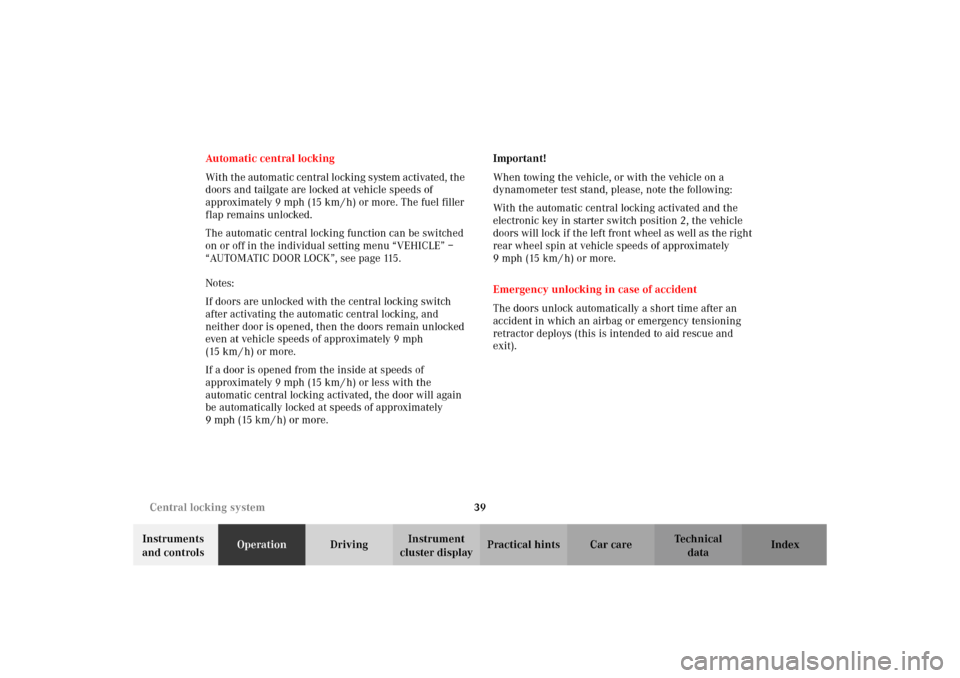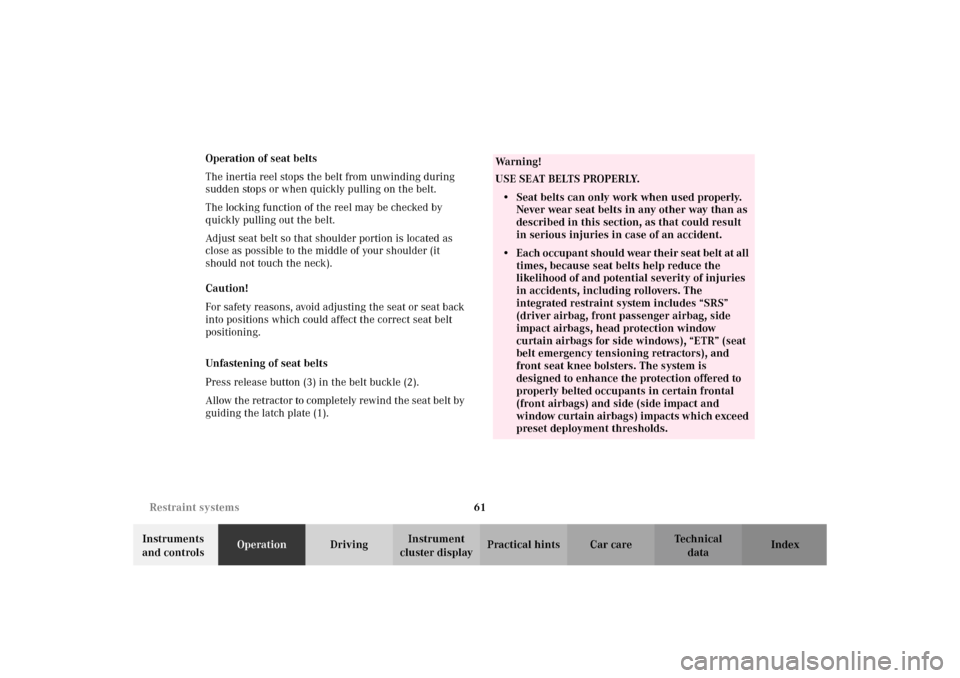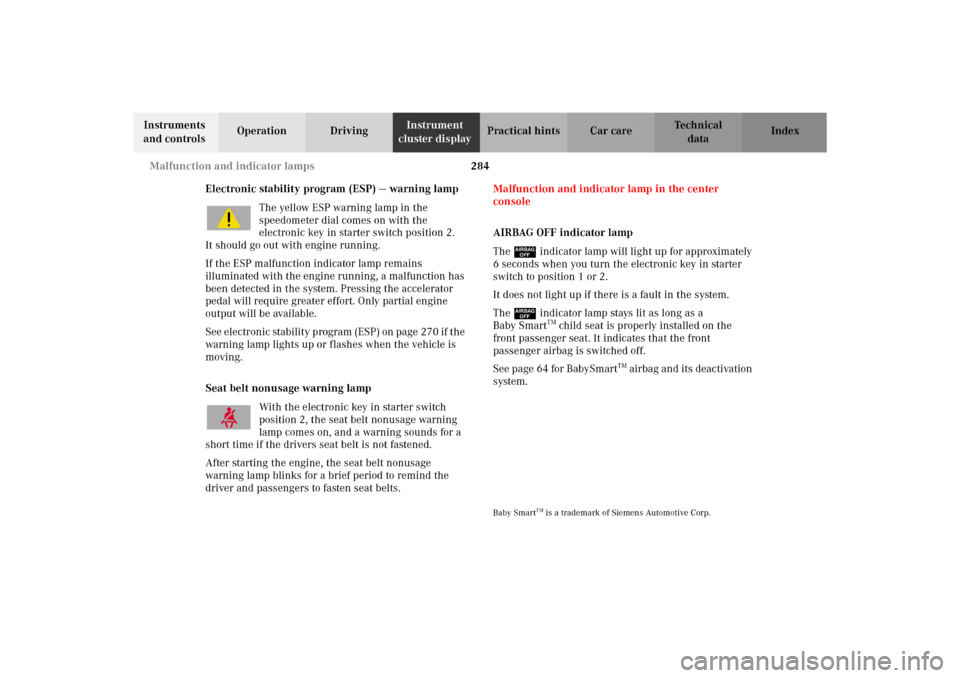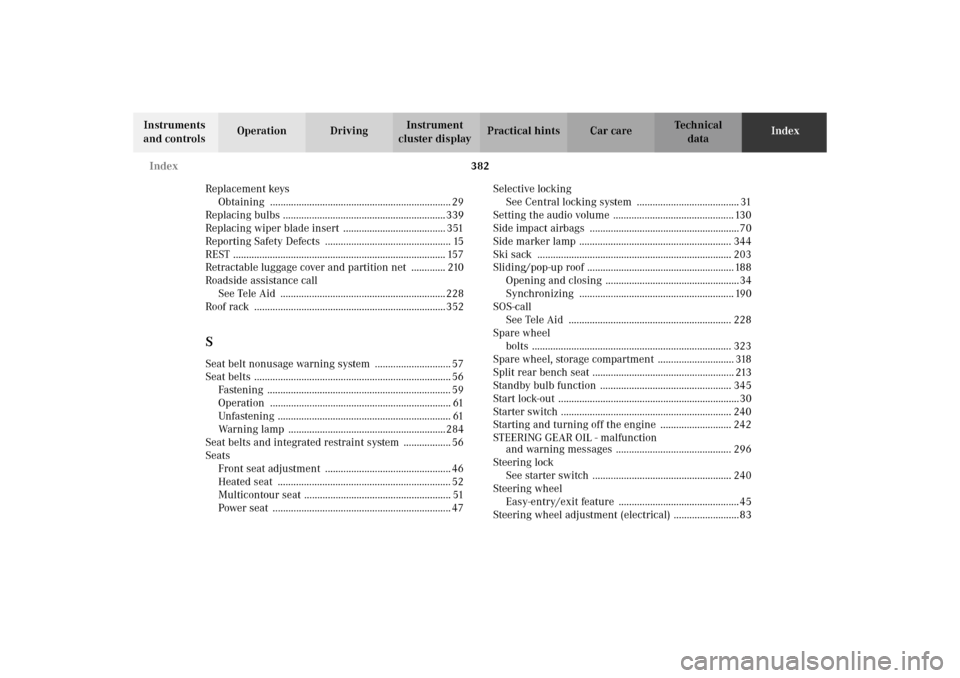2002 MERCEDES-BENZ C320 WAGON airbag off
[x] Cancel search: airbag offPage 7 of 390

4 Contents
DrivingControl and operation of
radio transmitters .....................226
The first 1 000 miles
(1 500 km) .................................227
Maintenance ...................................227
Tele Aid ...........................................228
Catalytic converter ........................238
Emission control ............................239
Starter switch .................................240
Starting and turning off
the engine ..................................242
Automatic transmission ...............243
Parking brake .................................252
Driving instructions ......................253
Drive sensibly – Save Fuel ........253
Drinking and driving .................253
Pedals ...........................................253
Power assistance ........................254
Brakes ..........................................254
Driving off ...................................255
Parking ........................................256
Tires .............................................257Snow chains ............................... 259
Winter driving
instructions ................................ 260
Deep water .................................. 262
Passenger compartment ........... 263
Traveling abroad ........................ 263
Cruise control ................................ 264
Brake assist system (BAS) ............ 267
Antilock brake system
(ABS) .......................................... 268
Electronic stability program
(ESP) ........................................... 270
What you should know
at the gas station .......................274
Check regularly and
before a long trip .......................276
Instrument cluster displayMalfunction and indicator lamps in
the instrument cluster ............. 278
On-board diagnostic system ........ 278
Check engine malfunction
indicator lamp ............................ 278
Brake warning lamp .................. 280Supplemental restraint system
(SRS) indicator lamp .................. 281
Fuel reserve warning .................282
ABS malfunction
indicator lamp .............................283
Electronic stability program
(ESP) — warning lamp ...............284
Seat belt nonusage
warning lamp ............................284
Malfunction and indicator
lamp in the center console ......284
AIRBAG OFF indicator lamp .....284
Malfunction and warning
messages in the
multifunction display ...............285
DISPLAY DEFECTIVE ................287
BATTERY / ALTERNATOR ........288
ANTILOCK BRAKE SYSTEM ....289
BRAKE ASSIST ...........................289
BRAKE PAD WEAR ....................290
BRAKE FLUID .............................290
PARKING BRAKE ....................... 291
SEAT BELT SYSTEM ................... 291
S203.book Seite 4 Freitag, 19. Oktober 2001 1:25 13
Page 27 of 390

24 Instruments and controls
Te ch n i c a l
data Instruments
and controlsOperation DrivingInstrument
cluster displayPractical hints Car care Index
Center console1Left front seat heater switch, see page 52
2Rear window wiper/washer, see page 146
3ESP (electronic stability program) control switch,
see page 270
4Hazard warning flasher switch, see page 147
5Central locking switch, see page 38
6Antitheft alarm system, see page 43
Switch for tow-away protection, see page 44
7Right front seat heater switch, see page 52
8AIRBAG OFF indicator lamp, see page 284
9COMAND system (optional), see separate
operating instructions, or
audio system, see page 161
10Automatic climate control, see page 148
Rear window defroster, see page 158
11Ashtray, see page 200
12Automatic transmission, see page 243
13Storage compartment, see page 196
14Armrest, see page 196
Storage compartment, see page 202
S203.book Seite 24 Freitag, 19. Oktober 2001 1:25 13
Page 42 of 390

39 Central locking system
Te ch n i c a l
data Instruments
and controlsOperationDrivingInstrument
cluster displayPractical hints Car care Index Automatic central locking
Wit h t he autom atic c entral lockin g s ystem ac tivate d, t he
doors and tailgate are locked at vehicle speeds of
approximately 9 mph (15 km / h) or more. The fuel filler
flap remains unlocked.
The automatic central locking function can be switched
on or off in the individual setting menu “VEHICLE” –
“AUTOMATIC DOOR LOCK”, see page 115.
Notes:
If doors are unlocked with the central locking switch
after activating the automatic central locking, and
neither door is opened, then the doors remain unlocked
even at vehicle speeds of approximately 9 mph
(15 km / h) or more.
If a door is opened from the inside at speeds of
approximately 9 mph (15 km / h) or less with the
automatic central locking activated, the door will again
be automatically locked at speeds of approximately
9 mph (15 km / h) or more.Important!
When towing the vehicle, or with the vehicle on a
dynamometer test stand, please, note the following:
With the automatic central locking activated and the
electronic key in starter switch position 2, the vehicle
doors will lock if the left front wheel as well as the right
rear wheel spin at vehicle speeds of approximately
9 mph (15 km / h) or more.
Emergency unlocking in case of accident
The doors unlock automatically a short time after an
accident in which an airbag or emergency tensioning
retractor deploys (this is intended to aid rescue and
exit).
S203.book Seite 39 Freitag, 19. Oktober 2001 1:25 13
Page 64 of 390

61 Restraint systems
Te ch n i c a l
data Instruments
and controlsOperationDrivingInstrument
cluster displayPractical hints Car care Index Operation of seat belts
The inertia reel stops the belt from unwinding during
sudden stops or when quickly pulling on the belt.
The locking function of the reel may be checked by
quickly pulling out the belt.
Adjust seat belt so that shoulder portion is located as
close as possible to the middle of your shoulder (it
should not touch the neck).
Caution!
For safety reasons, avoid adjusting the seat or seat back
into positions which could affect the correct seat belt
positioning.
Unfastening of seat belts
Press release button (3) in the belt buckle (2).
Allow the retractor to completely rewind the seat belt by
guiding the latch plate (1).
Wa r n i n g !
USE SEAT BELTS PROPERLY.• Seat belts can only work when used properly.
Never wear seat belts in any other way than as
described in this section, as that could result
in serious injuries in case of an accident.• Each occupant should wear their seat belt at all
times, because seat belts help reduce the
likelihood of and potential severity of injuries
in accidents, including rollovers. The
integrated restraint system includes “SRS”
(driver airbag, front passenger airbag, side
impact airbags, head protection window
curtain airbags for side windows), “ETR” (seat
belt emergency tensioning retractors), and
front seat knee bolsters. The system is
designed to enhance the protection offered to
properly belted occupants in certain frontal
(front airbags) and side (side impact and
window curtain airbags) impacts which exceed
preset deployment thresholds.
S203.book Seite 61 Freitag, 19. Oktober 2001 1:25 13
Page 76 of 390

73 Restraint systems
Te ch n i c a l
data Instruments
and controlsOperationDrivingInstrument
cluster displayPractical hints Car care Index
• Occupants, especially children, should never
lean their heads in the area of the door where
the side airbag inflates. This could result in
serious injuries or death should the airbag be
triggered.• Children 12 years old and under must never
ride in the front seat, except in a
Mercedes-Benz authorized Baby Smart
TM
compatible child seat, which operates with the
BabySmart
TM system installed in the vehicle to
deactivate the passenger side front airbag
when it is properly installed. Otherwise they
will be struck by the airbag when it inflates in
a crash. If this happens, serious or fatal injury
can result.
Failure to follow these instructions can result in
severe injuries to you or other occupants.
Wa r n i n g !
Accident research shows that the safest place for
children in an automobile is in the rear seat.
Should you choose to place a child 12 years old or
under in the front passenger seat of your vehicle,
you must properly use a BabySmart
TM child
restraint which will turn off the passenger side
front airbag. BabySmart
TM will not, however, turn
off the vehicle’s side impact airbag.
It should be noted that with respect to both front
and rear side impact airbags there is a possibility
for a side airbag related injury if occupants,
especially children, are not properly seated or
restrained when next to a side airbag which needs
to deploy rapidly in a side impact in order to do its
job.
S203.book Seite 73 Freitag, 19. Oktober 2001 1:25 13
Page 280 of 390

277 Contents - Instrument cluster display
Te ch n i c a l
data Instruments
and controlsOperation DrivingInstrument
cluster displayPractical hints Car care Index
Instrument cluster displayMalfunction and indicator lamps in
the instrument cluster .............278
On-board diagnostic system .........278
Check engine malfunction
indicator lamp .............................278
Brake warning lamp ..................280
Supplemental restraint system
(SRS) indicator lamp .................. 281
Fuel reserve warning .................282
ABS malfunction
indicator lamp .............................283
Electronic stability program
(ESP) — warning lamp ...............284
Seat belt nonusage
warning lamp .............................284Malfunction and indicator
lamp in the center console ...... 284
AIRBAG OFF indicator lamp .... 284
Malfunction and warning
messages in the
multifunction display .............. 285
DISPLAY DEFECTIVE ................ 287
BATTERY / ALTERNATOR ....... 288
ANTILOCK BRAKE SYSTEM .... 289
BRAKE ASSIST ........................... 289
BRAKE PAD WEAR .................... 290
BRAKE FLUID ............................ 290
PARKING BRAKE ....................... 291
SEAT BELT SYSTEM .................. 291
ELEC. STABIL. PROG.
(Electronic stability program) . 292
COOLANT
(coolant level) ............................. 293COOLANT
(coolant temperature) ................294
ENGINE OIL LEVEL ...................295
STEERING GEAR OIL .................296
LIGHTING SYSTEM ....................297
LAMP SENSOR ...........................299
DOOR ...........................................299
TRUNK OPEN .............................300
HOOD ...........................................300
TELEPHONE – FUNCTION ....... 301
TELE AID ..................................... 301
WASHER FLUID .........................302
RESTRAINT SYSTEM .................303
KEY ...............................................303
FUEL RESERVE ..........................304
UNDERVOLTAGE ........................304
S203.book Seite 277 Freitag, 19. Oktober 2001 1:25 13
Page 287 of 390

284 Malfunction and indicator lamps
Te ch n i c a l
data Instruments
and controlsOperation DrivingInstrument
cluster displayPractical hints Car care Index
Electronic stability program (ESP) — warning lamp
The yellow ESP warning lamp in the
speedometer dial comes on with the
electronic key in starter switch position 2.
It should go out with engine running.
If the ESP malfunction indicator lamp remains
illuminated with the engine running, a malfunction has
been detected in the system. Pressing the accelerator
pedal will require greater effort. Only partial engine
output will be available.
See electronic stability program (ESP) on page 270 if the
warning lamp lights up or flashes when the vehicle is
moving.
Seat belt nonusage warning lamp
With the electronic key in starter switch
position 2, the seat belt nonusage warning
lamp comes on, and a warning sounds for a
short time if the drivers seat belt is not fastened.
After starting the engine, the seat belt nonusage
warning lamp blinks for a brief period to remind the
driver and passengers to fasten seat belts.Malfunction and indicator lamp in the center
console
AIRBAG OFF indicator lamp
The ü indicator lamp will light up for approximately
6 seconds when you turn the electronic key in starter
switch to position 1 or 2.
It does not light up if there is a fault in the system.
The ü indicator lamp stays lit as long as a
Baby Smart
TM child seat is properly installed on the
front passenger seat. It indicates that the front
passenger airbag is switched off.
See page 64 for BabySmart
TM airbag and its deactivation
system.
Baby Smart
TM is a trademark of Siemens Automotive Corp.
S203.book Seite 284 Freitag, 19. Oktober 2001 1:25 13
Page 385 of 390

382 Index
Te ch n i c a l
data Instruments
and controlsOperation DrivingInstrument
cluster displayPractical hints Car careIndex
Replacement keys
Obtaining ..................................................................... 29
Replacing bulbs .............................................................. 339
Replacing wiper blade insert ....................................... 351
Reporting Safety Defects ................................................ 15
REST ................................................................................. 157
Retractable luggage cover and partition net ............. 210
Roadside assistance call
See Tele Aid ............................................................... 228
Roof rack .........................................................................352
SSeat belt nonusage warning system ............................. 57
Seat belts ........................................................................... 56
Fastening ...................................................................... 59
Operation ..................................................................... 61
Unfastening .................................................................. 61
Warning lamp ............................................................284
Seat belts and integrated restraint system .................. 56
Seats
Front seat adjustment ................................................ 46
Heated seat .................................................................. 52
Multicontour seat ........................................................ 51
Power seat .................................................................... 47Selective locking
See Central locking system ....................................... 31
Setting the audio volume .............................................. 130
Side impact airbags .........................................................70
Side marker lamp .......................................................... 344
Ski sack .......................................................................... 203
Sliding/pop-up roof ........................................................ 188
Opening and closing ...................................................34
Synchronizing ........................................................... 190
SOS-call
See Tele Aid .............................................................. 228
Spare wheel
bolts ............................................................................ 323
Spare wheel, storage compartment ............................. 318
Split rear bench seat ...................................................... 213
Standby bulb function .................................................. 345
Start lock-out .....................................................................30
Starter switch ................................................................. 240
Starting and turning off the engine ........................... 242
STEERING GEAR OIL - malfunction
and warning messages ............................................ 296
Steering lock
See starter switch ..................................................... 240
Steering wheel
Easy-entry/exit feature .............................................. 45
Steering wheel adjustment (electrical) .........................83
S203.book Seite 382 Freitag, 19. Oktober 2001 1:25 13